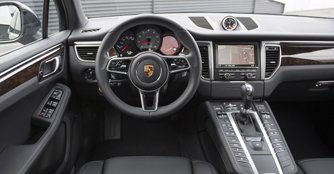Porsche Macan S 3.0 PDK (A) First Drive Review
03 Mar 2014|19,130 views
Porsche has a deep and long association with sports cars. The 911 is heralded as an icon - not just in its field but for the automotive industry as a whole. And no one knew exactly how it was able to withstand the test of time.
Then, Porsche started making cars that are more practical and with the family in mind. Naturally, there were raised brows and puzzled faces. But with chart-topping sales of the Panamera four-door GT and the Cayenne SUV, the marque proved that there are still many buyers who want a piece of Stuttgart's engineering.
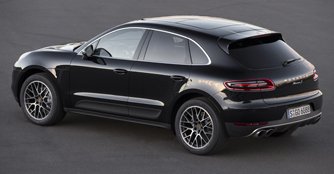
 The Macan may look nothing like the 911 or Cayman, but be assured that it embodies much of Porsche's sports carmaking expertise
The Macan may look nothing like the 911 or Cayman, but be assured that it embodies much of Porsche's sports carmaking expertise
In terms of sales figures, these models have even overtaken the 911s, testifying for Porsche's business acumen to penetrate the mass markets.
Now under the Volkswagen Group, it isn't surprising to know that Porsche has made clever use of its family ties. Like the Cayenne (which is built on the same architecture as the Volkswagen Touareg), the Macan shares its base with the Audi Q5.
Do not, however, be mistaken that the Q5 and Macan are cross-badged twins. There are real differences between them.
Then, Porsche started making cars that are more practical and with the family in mind. Naturally, there were raised brows and puzzled faces. But with chart-topping sales of the Panamera four-door GT and the Cayenne SUV, the marque proved that there are still many buyers who want a piece of Stuttgart's engineering.

In terms of sales figures, these models have even overtaken the 911s, testifying for Porsche's business acumen to penetrate the mass markets.
Now under the Volkswagen Group, it isn't surprising to know that Porsche has made clever use of its family ties. Like the Cayenne (which is built on the same architecture as the Volkswagen Touareg), the Macan shares its base with the Audi Q5.
Do not, however, be mistaken that the Q5 and Macan are cross-badged twins. There are real differences between them.
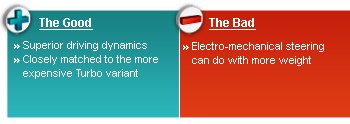 |
Up close and Personal
From the front, the Macan borrows design cues from the Cayenne - and is unmistakably a Porsche. It could even be mistaken for its bigger brother at first glance.
The rear is where the differences are. It seems that Porsche has cut no slack in giving the Macan the sports car appeal, with its tail lamp design taking direct cues from the 918 halo car.
There are a handful of subtle hints to differentiate this S variant from the more powerful Macan Turbo. The most distinct are the smaller front bumper air scoops and round tailpipes (Turbo gets squared-off tips on its quad exhaust).
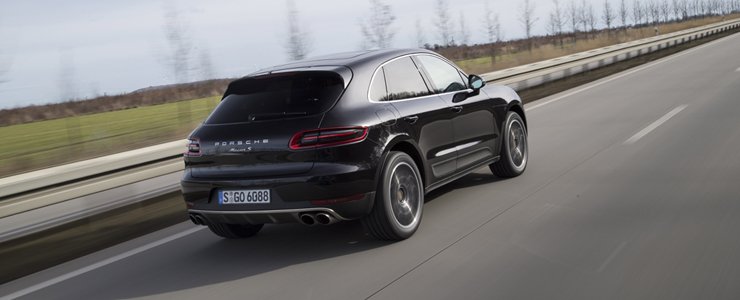 |
The Drive
The Macan is further differentiated from its Audi counterpart in the terms of drivetrain. While the Q5's all-wheel drive system has a 40:60 force distribution, the Macan utilises a rear-biased 20:80 split. The concept is taken from 911 Carrera 4 models, and gives the Macan a more pleasurable rear-wheel drive experience.
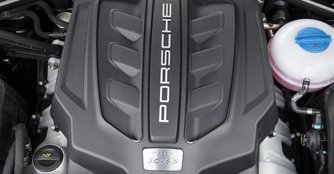
 The Macan S's 3.0-litre V6 delivers more power-per-litre than the 3.6-litre unit in the Turbo - churning out 113bhp/litre compared to 110bhp/litre from the latter
The Macan S's 3.0-litre V6 delivers more power-per-litre than the 3.6-litre unit in the Turbo - churning out 113bhp/litre compared to 110bhp/litre from the latter
When the situation arises, however, the clever and flexible electronically controlled multi-plate clutch system can put 100 percent of available torque to the front axle for maximum traction. There is even a bar meter on the instrument console to tell you how much torque is sent to each individual axle at any given time.
Despite the lower horsepower figures, the Macan S will claim a century sprint timing just 0.6 of a second slower than the Turbo - 5.4 seconds versus 4.8 seconds on the latter.
In city traffic, the drop in performance is barely noticeable. It is only on the Autobahn where the S feels slightly weaker above speeds of 150km/h, whereas the Turbo will pull strongly till beyond 180km/h.
The Macan is further differentiated from its Audi counterpart in the terms of drivetrain. While the Q5's all-wheel drive system has a 40:60 force distribution, the Macan utilises a rear-biased 20:80 split. The concept is taken from 911 Carrera 4 models, and gives the Macan a more pleasurable rear-wheel drive experience.

When the situation arises, however, the clever and flexible electronically controlled multi-plate clutch system can put 100 percent of available torque to the front axle for maximum traction. There is even a bar meter on the instrument console to tell you how much torque is sent to each individual axle at any given time.
Despite the lower horsepower figures, the Macan S will claim a century sprint timing just 0.6 of a second slower than the Turbo - 5.4 seconds versus 4.8 seconds on the latter.
In city traffic, the drop in performance is barely noticeable. It is only on the Autobahn where the S feels slightly weaker above speeds of 150km/h, whereas the Turbo will pull strongly till beyond 180km/h.
Like the Macan Turbo, the letdown in the S is the electric-mechanical steering that feels featherlight-like in a sedan, and does not give a good sense of the size of the car you are piloting.
Fitted with the optional Porsche Active Suspension Management or PASM (standard on the Turbo), the Macan S' ride is well-sorted even when driven enthusiastically and putting through corners at high speeds.
Conclusion
Having tried both the S and Turbo variants of the Macan within a short period of time, we have to say that they are very closely matched.
Boasting rights aside and depending on how well they are equipped when they reach our shores in July this year, the gap between them may even be too close for comfort.
Fitted with the optional Porsche Active Suspension Management or PASM (standard on the Turbo), the Macan S' ride is well-sorted even when driven enthusiastically and putting through corners at high speeds.
Conclusion
Having tried both the S and Turbo variants of the Macan within a short period of time, we have to say that they are very closely matched.
Boasting rights aside and depending on how well they are equipped when they reach our shores in July this year, the gap between them may even be too close for comfort.
Porsche has a deep and long association with sports cars. The 911 is heralded as an icon - not just in its field but for the automotive industry as a whole. And no one knew exactly how it was able to withstand the test of time.
Then, Porsche started making cars that are more practical and with the family in mind. Naturally, there were raised brows and puzzled faces. But with chart-topping sales of the Panamera four-door GT and the Cayenne SUV, the marque proved that there are still many buyers who want a piece of Stuttgart's engineering.
In terms of sales figures, these models have even overtaken the 911s, testifying for Porsche's business acumen to penetrate the mass markets.
Now under the Volkswagen Group, it isn't surprising to know that Porsche has made clever use of its family ties. Like the Cayenne (which is built on the same architecture as the Volkswagen Touareg), the Macan shares its base with the Audi Q5.
Do not, however, be mistaken that the Q5 and Macan are cross-badged twins. There are real differences between them.
Then, Porsche started making cars that are more practical and with the family in mind. Naturally, there were raised brows and puzzled faces. But with chart-topping sales of the Panamera four-door GT and the Cayenne SUV, the marque proved that there are still many buyers who want a piece of Stuttgart's engineering.
In terms of sales figures, these models have even overtaken the 911s, testifying for Porsche's business acumen to penetrate the mass markets.
Now under the Volkswagen Group, it isn't surprising to know that Porsche has made clever use of its family ties. Like the Cayenne (which is built on the same architecture as the Volkswagen Touareg), the Macan shares its base with the Audi Q5.
Do not, however, be mistaken that the Q5 and Macan are cross-badged twins. There are real differences between them.
Up close and Personal
From the front, the Macan borrows design cues from the Cayenne - and is unmistakably a Porsche. It could even be mistaken for its bigger brother at first glance.
The rear is where the differences are. It seems that Porsche has cut no slack in giving the Macan the sports car appeal, with its tail lamp design taking direct cues from the 918 halo car.
There are a handful of subtle hints to differentiate this S variant from the more powerful Macan Turbo. The most distinct are the smaller front bumper air scoops and round tailpipes (Turbo gets squared-off tips on its quad exhaust).
The Drive
The Macan is further differentiated from its Audi counterpart in the terms of drivetrain. While the Q5's all-wheel drive system has a 40:60 force distribution, the Macan utilises a rear-biased 20:80 split. The concept is taken from 911 Carrera 4 models, and gives the Macan a more pleasurable rear-wheel drive experience.
When the situation arises, however, the clever and flexible electronically controlled multi-plate clutch system can put 100 percent of available torque to the front axle for maximum traction. There is even a bar meter on the instrument console to tell you how much torque is sent to each individual axle at any given time.
Despite the lower horsepower figures, the Macan S will claim a century sprint timing just 0.6 of a second slower than the Turbo - 5.4 seconds versus 4.8 seconds on the latter.
In city traffic, the drop in performance is barely noticeable. It is only on the Autobahn where the S feels slightly weaker above speeds of 150km/h, whereas the Turbo will pull strongly till beyond 180km/h.
The Macan is further differentiated from its Audi counterpart in the terms of drivetrain. While the Q5's all-wheel drive system has a 40:60 force distribution, the Macan utilises a rear-biased 20:80 split. The concept is taken from 911 Carrera 4 models, and gives the Macan a more pleasurable rear-wheel drive experience.
When the situation arises, however, the clever and flexible electronically controlled multi-plate clutch system can put 100 percent of available torque to the front axle for maximum traction. There is even a bar meter on the instrument console to tell you how much torque is sent to each individual axle at any given time.
Despite the lower horsepower figures, the Macan S will claim a century sprint timing just 0.6 of a second slower than the Turbo - 5.4 seconds versus 4.8 seconds on the latter.
In city traffic, the drop in performance is barely noticeable. It is only on the Autobahn where the S feels slightly weaker above speeds of 150km/h, whereas the Turbo will pull strongly till beyond 180km/h.
Like the Macan Turbo, the letdown in the S is the electric-mechanical steering that feels featherlight-like in a sedan, and does not give a good sense of the size of the car you are piloting.
Fitted with the optional Porsche Active Suspension Management or PASM (standard on the Turbo), the Macan S' ride is well-sorted even when driven enthusiastically and putting through corners at high speeds.
Conclusion
Having tried both the S and Turbo variants of the Macan within a short period of time, we have to say that they are very closely matched.
Boasting rights aside and depending on how well they are equipped when they reach our shores in July this year, the gap between them may even be too close for comfort.
Fitted with the optional Porsche Active Suspension Management or PASM (standard on the Turbo), the Macan S' ride is well-sorted even when driven enthusiastically and putting through corners at high speeds.
Conclusion
Having tried both the S and Turbo variants of the Macan within a short period of time, we have to say that they are very closely matched.
Boasting rights aside and depending on how well they are equipped when they reach our shores in July this year, the gap between them may even be too close for comfort.
Thank You For Your Subscription.
















